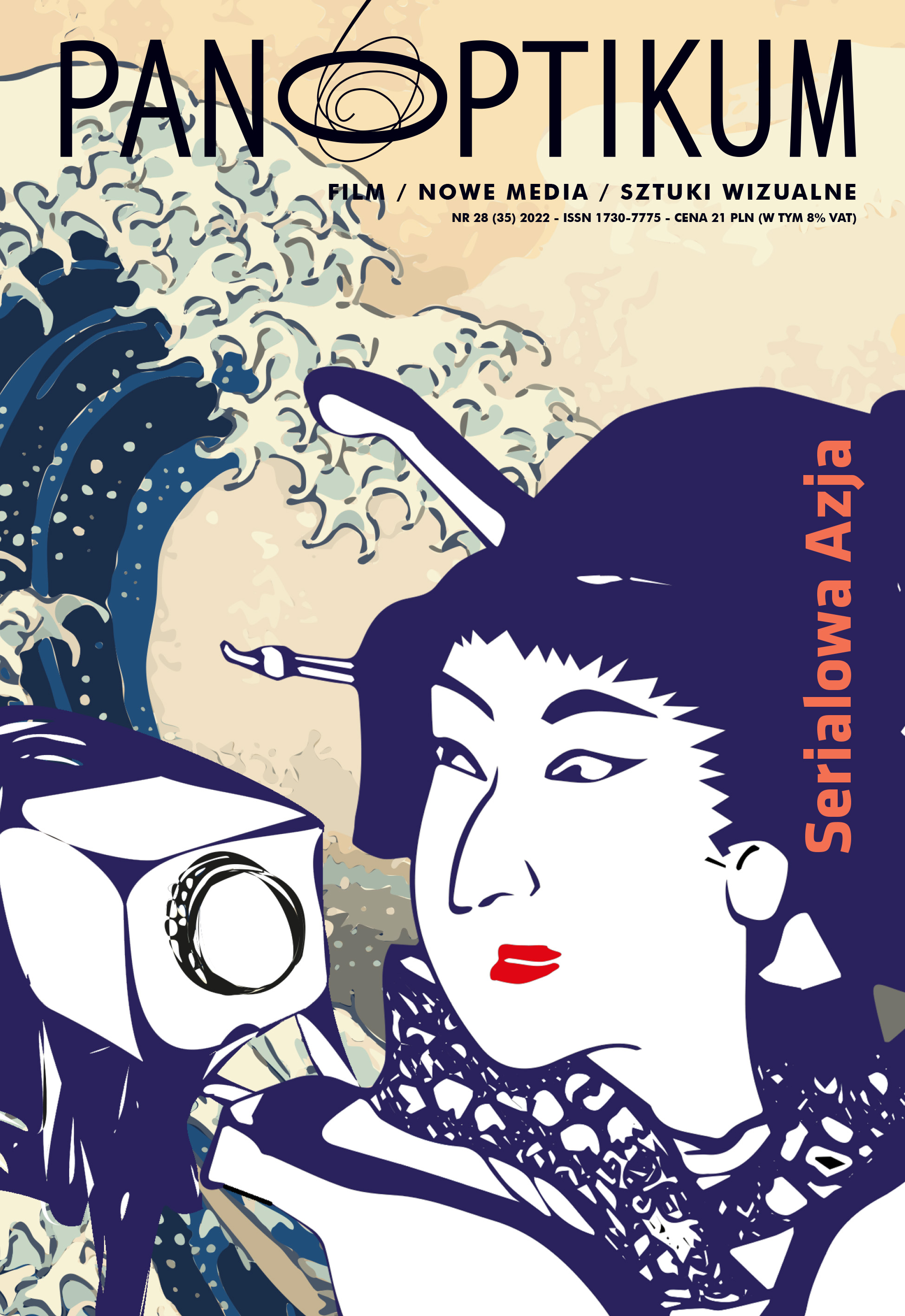Analiza wizerunku poselstw państwa Ming w koreańskich serialach kostiumowych na tle relacji chińsko-koreańskich
DOI:
https://doi.org/10.26881/pan.2022.28.03Słowa kluczowe:
k-drama, ubiór, Ming, posełAbstrakt
The paper analyses the portrayal of Ming envoys in South Korean dramas. The four series, i.e. Wang-i doen namja, Baegir-ui Nanggunnim, Wang-ui Eolgul and Yeon-mo are taken under consideration. Conducted analysis shows that the presented image is often incorrect in terms of hairstyles or clothing, and envoys show questionable etiquette. Moreover, the quality of the used Chinese emissaries costumes seems to be lower than the Korean characters. Image is used as a tool to differentiate Chinese and Koreans. Furthermore, it is a part of a broader picture of flared-up discussion on what Koreans should wear and who can wear Korean clothes.
Downloads
Bibliografia
Buckley Ebrey, P. (2010). The Cambridge Illustrated History of China (wyd. 2). Cambridge: Cambridge University Press.
Cammann, S. (2001). China’s Dragon Robes. Chicago: Art Media Resources.
Confucius (2003). Confucius Analects: With Selection from Traditional Commentaries, przeł. E. Slingerland. Indianapolis: Hackett Publishing Company.
Du, Y., Liangyun, M., red. (2000). 中国衣经 (zhongguo yijing). Shanghai: Shanghai wenhua chubanshe.
Eng, R.Y. (28.03.2011). China-Korea Culture Wars and National Myths: TV Dramas as Battleground. „The Asia-Pacific Journal”, vol. 9, is. 13, no. 4.
Gao, G. (2005). 细说中国服饰: 彩图版 (xishuo zhongguo fushi: cai tuban). Beijing: Guangming ribao chubanshe.
Gries, P., Yasuki, M. (2022). How History Wars Shape Foreign Policy: An Ancient Kingdom and the Future of China – South Korea Relations. „Journal of East Asian Studies”, vol. 22.
Huang, N., Juanjuan, Ch. (1995). 中国服装史 (zhongguo fuzhuang shi). Beijing: Zhongguo lüyou chubanshe.
Huang, N., Qiaoling, Q. (2009). 衣冠天下: 中国服装图史 (yiguan tianxia: zhongguo fuzhuang tu shi). Beijing: Zhonghua shuju.
Jie, Y. (6.02.2022). Koreans Take Umbrage at Presence of Hanbok at Beijing Winter Olympics Ceremony. The Korea Herald. http://www.koreaherald.com/view.php?ud=20220206000176 (dostęp: 18.05.2022).
Jo, J.O. (2022). Korean Dramas, Circulation of Affect and Digital Assemblages: Korean Soft Power in the United States, [w:] K. Youna (red.) The Soft Power of the Korean Wave: Parasite, BTS and Drama. New York: Routledge.
Ju, H. (2022). K-Dramas Meet Netflix: New Models of Collaboration with the Figital West, [w:] K. Youna (red.), The Soft Power of the Korean Wave: Parasite, BTS and Drama. New York: Routledge.
Ministry of Culture, Sports and Tourism (2011). The Korean Wave: A New Pop Culture Phenomenon. Korea: Korean Culture and Information Service.
Lee, S.S. (2013). Hanbok: Timeless Fashion Tradition. Seoul: Seoul Selection.
Legge, J., przeł. (1885). The Li Ki, I–X. Oxford: The Clarendon Press.
National Ethnic Affairs Commission of the People’s Republic of China (n.d.). 朝鲜族 (chaoxian zu). https://www.neac.gov.cn/seac/ztzl/cxz/gk.shtml (dostęp: 18.05.2022).
National Institute of Korean History (n.d.a). The Abdicated King Discusses How To Explain His Abdication To The Imperial Envoy. The Veritable Records of King Sejong. http://esillok. history.go.kr/record/recordView.do?id=eda_10008023&yearViewType=byReign&sillokViewType=Eng&searchYear=1418&searchYearMonth=1418-08&searchMonthType=L0&search YearMonthDay=1418-08-30&searchDateId=eda_10008030 (dostęp: 13.05.2022).
National Institute of Korean History (n.d.b). The King And Officials Discuss The Wearing Of The Ornamental Belt The Emperor Bestowed Upon The King.The Veritable Records of King Sejong. http://esillok.history.go.kr/record/recordView.do?id=eda_11207028_001&yearViewType=byReign&sillokViewType=Eng&searchYear=&searchYearMonth=&search MonthType=&searchYearMonthDay=&searchDateId= (dostęp: 19.05.2022).
Netflix (n.d.). Global Top 10. https://top10.netflix.com/ (dostęp: 29.12.2022).
Nielsen (5.02.2015). 지상파 일일 – Top 20 List for TV Programs. https://www.nielhttps://www.nielsenkorea.co.kr/tv_terrestrial_day.asp?menu=Tit_1&sub_menu=1_1&area=00&begin_date=20211214senkorea.co.kr/tv_terrestrial_day.asp?menu=Tit_1&sub_menu=1_1&area=00&begin_date=20211214 (dostęp: 29.12.2022).
Nye, J.S., Jr. (2004). Soft Power: The Means to Success in World Politics. New York: Public Affairs.
Preview. https://www.preview.ph/culture/top-20-highest-rating-korean-dramas-a00268-20200519-lfrm (dostęp: 29.12.2022).
Prown, J.D. (1982). Mind in Matter: An Introduction to Material Culture Theory and Method. „Winterthur Portfolio”, vol. 17, no. 1.
Song, S. (25.03.2021). SBS Drama ‘Joseon Exorcist’ Takes Beating Over Historical Inaccuracies. The Korea Herald. http://www.koreaherald.com/view.php?ud=20210325000951 (dostęp: 18.05.2022).
The Met (n.d.). Elegant Gathering in the Apricot Garden. https://www.metmuseum.org/art/collection/search/41478 (dostęp: 13.05.2022).
Tsai, S.H. (1996). The Eunuchs in the Ming Dynasty. Albany: State University of New York Press.
Xi zhai zhuren (西斋主人) (16.02.2021). Hanfu and Hanbok 谁抄袭谁 (shei chaoxi shei?). https://www.youtube.com/watch?v=lmwrGU0UP48 (dostęp: 7.10.2022).
Zhang, T. (1974). 明史 (ming shi). Zhonghua shuju.
Zhou, X., Chunming, G. (1996). 中国衣冠服饰大辞典 (zhongguo yiguan fushi da cidian). Shanghai: Shanghai cishu chubanshe.

 Uniwersyteckie Czasopisma Naukowe
Uniwersyteckie Czasopisma Naukowe









